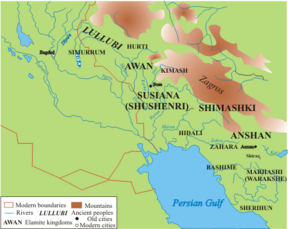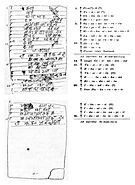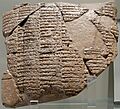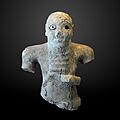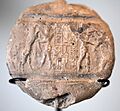Awan dynasty facts for kids
Quick facts for kids Awan dynasty𒈗𒂊𒉈𒀀𒉿𒀭𒆠 lugal-e-ne a-wa-anki
|
|
|---|---|
|
Awan dynasty
Territory of the Awan in the Mesopotamia area.
Dynastic list of twelve kings of Awan dynasty and twelve kings of the Shimashki Dynasty, 1800–1600 BCE, Louvre Museum Sb 17729.
|
|
| Current region | Elam |
|
Elamites remained a major source of tension after Awan's defeat
|
|
The Awan Dynasty (in Sumerian: 𒈗𒂊𒉈𒀀𒉿𒀭𒆠 lugal-e-ne a-wa-anki, meaning "Kings of Awan") was one of the earliest ruling families of Elam. Elam was an ancient civilization located in what is now southwestern Iran. We don't know much about the Awan Dynasty because it existed very long ago, at the start of recorded history.
This dynasty was part of the early Old Elamite period, which lasted from about 2700 BC to 1600 BC. After the Awan Dynasty, the Shimashki Dynasty took over, followed by the Sukkalmah Dynasty. The people of Elam were often rivals with their neighbors in Sumer, a powerful civilization in ancient Mesopotamia. Ancient texts say that kings from Sumer, like Enmebaragesi of Kish and Eannatum I of Lagash, fought against the Elamites and defeated them.
Awan was either a city-state or a region within Elam. Its exact location is still a mystery. Some historians think it was north of Susa, in southern Luristan, near Dezful, or at a place called Godin Tepe.
Contents
Awan's Place in Ancient History
Ancient texts, like the Sumerian King List, suggest that a dynasty from Awan ruled over Sumer after defeating the First Dynasty of Ur. This probably happened around 2500 BC. The list mentions three Awan kings who supposedly ruled for a total of 356 years. We don't know their full names, except for a part of the third king's name, "Ku-ul...". While this information might not be completely accurate, it shows that Awan was an important political power around 3000 BC.
Another list found in Susa names 12 kings of the Awan dynasty. Some of these names are Pieli, Luhhiššan, and Puzur-Inšušinak. Since there are not many other records from this time, we don't know much about what these kings did. However, Elam seemed to have a lot of trade with the Sumerian city-states. They mainly imported food and exported things like cattle, wool, and silver. There's even a record of tin being sent to an Elamite city to be turned into bronze. This might mean the Elamites had advanced metalworking skills.
The Awan kings also attacked Mesopotamia, clashing with powerful city-states like Kish and Lagash. One story tells of 600 Elamites who were stopped and defeated while trying to steal goods from a port.
Awan and the Akkadian Empire
Things become clearer when the Akkadian Empire rose to power around 2300 BC. Historical texts from this time describe military campaigns by the kings of Akkad into the Iranian plateau. Sargon of Akkad, a famous Akkadian king, claimed to have defeated a king of Elam named Luh-ishan and took treasures from Awan. Luh-ishan is listed as the eighth king on the Awan king list.
Sargon's son, Rimush, also conquered Elam. He defeated an Elamite king named Emahsini. Although Emahsini's name isn't on the Awan king list, Rimush's records say that the combined armies of Elam and Warahshe were defeated in a battle between Awan and Susa. This suggests that Awan and Susa were close to each other.
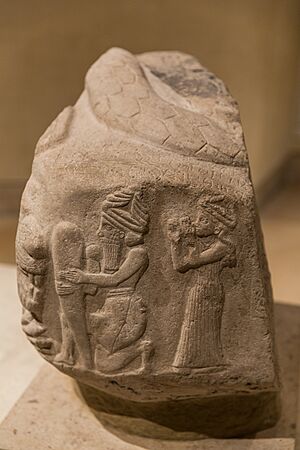
After these defeats, the western parts of Elam became controlled by Akkad, with Susa as a key city. A very important historical document, a peace treaty between Naram-Sin of Akkad and an unnamed king of Awan (possibly Khita or Helu), confirms this. This treaty is the oldest known document written in Elamite cuneiform, which is the ancient writing system of Elam.
Even though Awan was defeated, the Elamites were not completely taken over. Their capital, Anshan, was in a mountainous area that the Akkadians never reached. The Elamites continued to cause problems for the Akkadian state, eventually helping to weaken it until it collapsed.
The Powerful King Kutik-Inshushinak
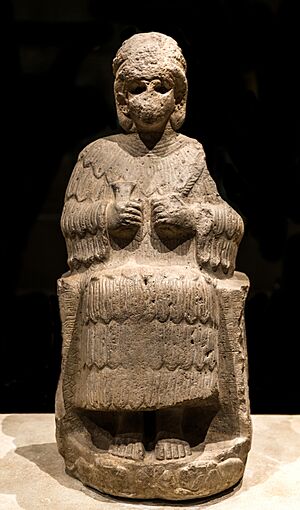
When the Akkadian Empire began to fall apart around 2240 BC, a man named Kutik-Inshushinak (also known as Puzur-Inshushinak) became very important. He was the governor of Susa, working for Akkad. But he freed Awan and Elam from Akkadian rule and became king.
By this time, Susa was becoming a very important city in Elam. Kutik-Inshushinak made it even more grand, building many temples and monuments. He then defeated neighboring towns that rebelled against him, even destroying 70 cities in one day! He became a powerful king, defeating all his rivals and taking control of Anshan, the capital.
Not stopping there, he launched military campaigns into northern Sumer, capturing important cities like Eshnunna. When he finally conquered Akkad, he declared himself "king of the four quarters," meaning he ruled the known world. However, his reign eventually ended when Ur-Nammu of Ur, who founded the Third Dynasty of Ur, defeated Elam. This marked the end of the Awan dynasty.
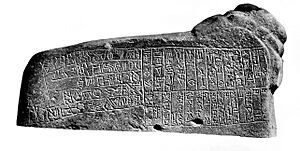
Kutik-Inshushinak was not just a conqueror. He also helped organize Elam and set up its government. He expanded the temple of the god Inshushinak and put a statue there.
After Kutik-Inshushinak's defeat, the Awan dynasty disappeared from history. It was likely overthrown by tribes like the Guti or Lullubi, who caused a lot of trouble in Mesopotamia. Elam then came under the control of the Shimashki dynasty.
Awan's Legacy
The name "Awan" is rarely mentioned after Kutik-Inshushinak's time. However, the name Anshan became much more common. Some historians believe that Anshan not only replaced Awan as a major part of Elam but also included the same territory.
Images for kids


